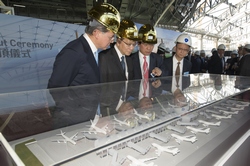
Air cargo demand and passenger numbers remained robust for Asia-Pacific carriers in October as indicated by global traffic figures released by the Association of Asia Pacific Airlines (AAPA).
Regional airlines carried 21.9 million international passengers in October, 6.9% more than in the same month last year, with positive economic conditions in the region lending support to business and leisure travel markets. Demand in revenue passenger kilometer terms increased by 5.3%, reflecting the relative strength of regional travel markets. Available seat capacity also increased by 6.9%, resulting in a 1.1 percentage point fall in the average international passenger load factor to 75.3%.
As measured in freight tonne kilometers, airfreight traffic grew by a firm 6.4% for the month on buoyant demand for electronic goods from manufacturing hubs in North Asia. Combined with a more modest 3.8% increase in offered freight capacity, the average international freight load factor climbed 1.5 percentage points to average 66.4% for the month.
“During the first ten months of the year, Asia-Pacific airlines carried a combined total of 212.5 million international passengers, an increase of 4.8% compared to the same period last year,” said Andrew Herdman, AAPA director general. “Airfreight markets grew by 5.1% within the same period. Generally positive regional economic conditions and trade gains provided support for continued growth in both passenger and cargo market segments.”
Herdman added, “Whilst the longer term demand outlook is positive, Asian airlines continue to grapple with numerous challenges, including persistent yield pressures arising from intense market competition and signs of overcapacity. Overall, Asian carriers remain positive on the outlook for further growth, but are still carefully controlling costs in a bid to restore profitability to more sustainable levels.”
Hong Kong airport’s topping-out rites
Meanwhile, the Airport Authority Hong Kong (AAHK) held a topping-out ceremony for the concourse construction at Hong Kong International Airport (HKIA), a core part of the authority’s midfield development project targeted for completion by end-2015.
In his address, AAHK chairman Vincent Lo said, “The Midfield expansion will come just in time to help HKIA meet its faster-than-expected traffic growth. Last year we saw another record-breaking year for passenger volume and flight movements. With the completion of the new passenger concourse, HKIA will be able to serve an additional 10 million passengers a year.”
Professor Anthony Cheung, Secretary for Transport and Housing, said that air traffic at HKIA has grown by 65% over the past decade, and HKIA saw year-on-year passenger and cargo growth of 5.6% and 6.4% respectively up to October this year.
Located west of Terminal 1 between the two existing runways, the 105,000-square-meter, five-level midfield concourse will be equipped with 20 new aircraft parking stands, for access by passengers from Terminal 1 via an extended automated people mover.
Began in 2011, the development’s construction is within a budget of more than HK$10 billion (US$1.29 billion).
The two executives also gave an update on the three-runway system project, the AAHK’s long-term solution to expand capacity at the aviation hub.
Lo said, “We are delighted that, after more than two years of vigorous environmental impact assessment and intensive public engagement, the Director of Environmental Protection has issued the Environmental Permit for the proposed 3RS project. We will proceed with completing the other necessary statutory requirements for the 3RS in the coming months, with a target of having it fully operational in 2023.”
Cheung added, “I am pleased to see the AA making an important step forward by completing a thorough Environmental Impact Assessment process and recently obtaining the Environmental Permit for the Third Runway. The next step will be formulating detailed design, work plans and funding arrangements.”
Photo courtesy of HKIA




